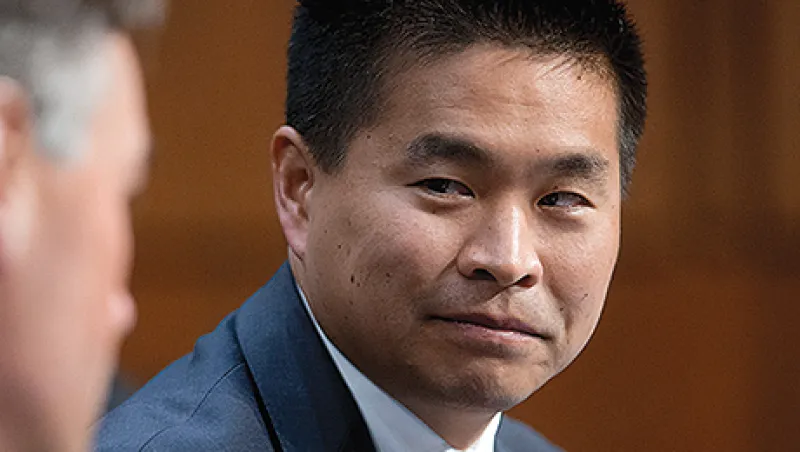Ever since IEX Group launched in 2013, co-founder and chief executive Bradley Katsuyama has aimed to turn the dark pool into a major public venue. IEX made powerful friends and enemies after being cast as the hero in Michael Lewis’s 2014 best-seller Flash Boys: A Wall Street Revolt, and both sides have turned out in force as the Securities and Exchange Commission approaches its March 21 deadline to rule on the firm’s application to become a full-fledged stock exchange. Hundreds of letters have flooded the SEC debating whether the alternative trading system’s built-in speed bump, touted as protection for investors against predatory high frequency traders, violates existing regulations.
“If IEX is approved for a market that has a speed bump, speed becomes less important,” Katsuyama tells Institutional Investor at his New York office. “That’s bad if you’re selling speed like the exchanges or if you need speed as your only method of making money.”
Winning approval would give the second-largest U.S. dark pool, which accounts for 1.7 percent of total daily equities trading volume, up from 0.9 percent at the start of 2015, a chance to expand as it squares off against the likes of the New York Stock Exchange (25 percent), Bats Global Markets (21 percent) and Nasdaq (17 percent). Since IEX filed its application last September, its supporters have included Goldman Sachs Group, Greenlight Capital, Pershing Square Capital Management and the Teacher Retirement System of Texas. But the firm’s bid for public status remains uncertain as would-be competitors and automated traders contest the fairness of allowing the firm’s patent-pending technology.
IEX’s smart order router has drawn the most fire from critics, who contend that it allows the platform to trade using nonpublic information. Under current operations, IEX sends trade notifications to buyers and sellers through the speed bump, which gives it a 350-microsecond head start for filling routable orders on other exchanges.
In a November letter to the SEC, Nasdaq argued that such time delays violate Regulation National Market System, or Reg NMS, which dictates that stock trades occur on whichever venue offers the best price at a given time. Jeffrey Sprecher, head of Intercontinental Exchange and chair of its subsidiary NYSE, said it would be “un-American” to grant the application without overhauling Reg NMS. “We laughed about that,” says Katsuyama, a native of Markham, Ontario, who insists that these arguments are intended to block free-market competition.
The 37-year-old springs from his desk to draw a diagram of the IEX router on a glass wall. “We don’t slow our router down because it prevents our clients from being electronically front-run. Period,” he says, brandishing a blue dry-erase pen.
Katsuyama experienced front running firsthand as global head of electronic sales and trading for RBC Capital Markets, where in 2009 his small team discovered that faster traders could detect when the bank had placed a large order and would race to buy stock on the exchanges to capitalize on the consequent uptick in price.
In 2012, Katsuyama and some RBC colleagues left to found IEX, fashioning their speed bump, officially known as the POP (for point-of-presence), out of 38 miles of fiber optic cable to jackknife these so-called latency arbitrage strategies. “We have very sophisticated technology, but we know we’re not the fastest,” says Robert Park, IEX’s chief technology officer. “The POP gives our matching engine enough time to become aware of price changes on away venues, so we’re pricing orders at current prices, not stale prices.”
Richard Ketchum, CEO of the Financial Industry Regulatory Authority, said in a February speech that current regulations are flexible enough to accommodate the speed bump. However, Ketchum didn’t weigh in on arguments against the router, calling them “the most difficult ones for the SEC to work through.”
For Katsuyama, it’s all or nothing. He says his firm, which can reapply if the SEC rules against it, won’t launch as a public exchange without the router and the speed bump. “If we’re declined, we’ll keep fighting,” Katsuyama vows. “We have money, we have support, and we’ll fight as long as it takes.”
Follow Jess Delaney on Twitter at @jdelaney_NYC.






